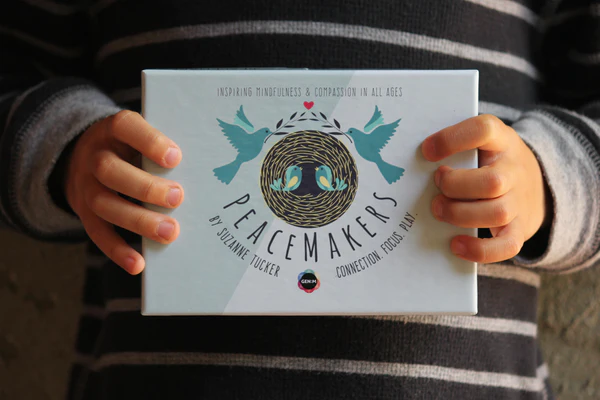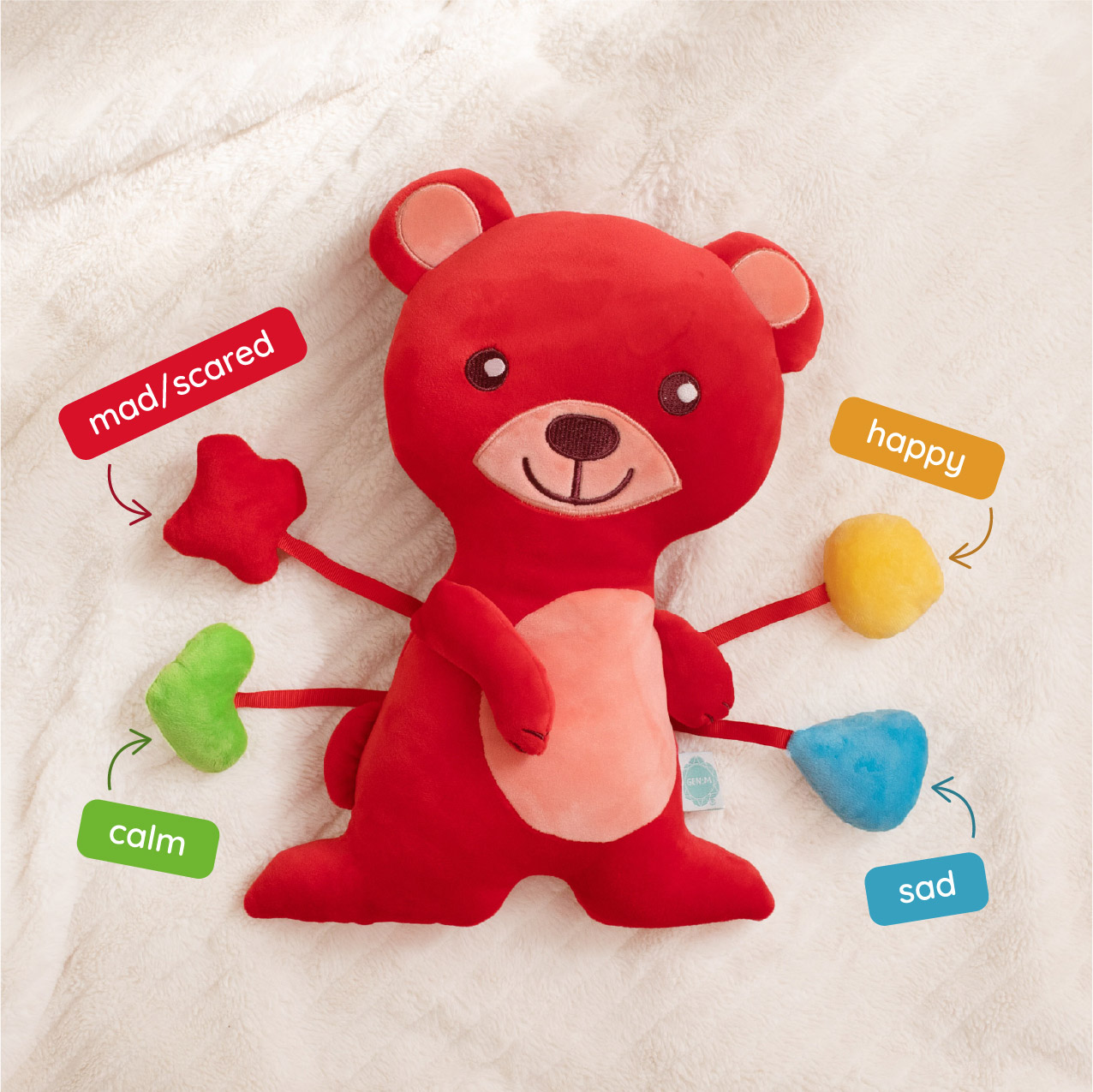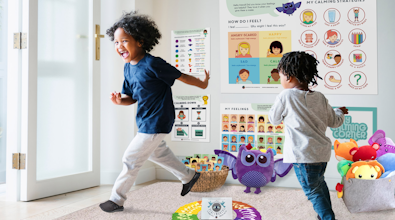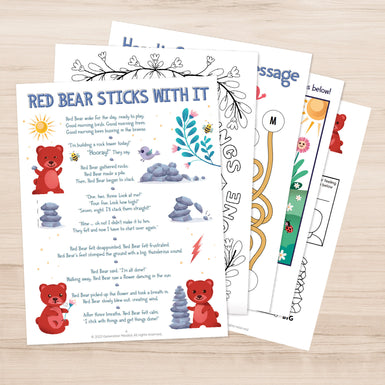Your four-year-old daughter drops to the floor in a puddle, arms and legs flailing. She wants the choo-choo train her baby brother is holding, despite the basket of toy trains that sit on the floor right next to her.
All too fast, your daughter’s flailing arms kick a pillow off the couch and, womp, the pillow lands smack dab onto baby brother's head. You watch on helplessly from about five feet away as your son topples to his side and begins to wail.
Your daughter holds the prized train up high over her head, well out of reach from little hands, and continues to scream.
Both of your children are now crying, and your anger hits a boiling point.
So what do you do?
In the past, you've tried putting your daughter in time-out on the steps but, being the strong-willed child that she is, she ignores your directives and immediately gets up off the step, placing the two of you into a locked-horns power struggle. Forcing her raging body back onto the step and leaving her in isolation seems cruel and ineffective, after all, your goal is not to control your daughter, it's to teach her how to control herself.
If any of this rings true for you, then setting up a calming space in your home might be the game-changing solution you've been looking for.
What Is A Time-In?
Time-ins help children learn how to manage their feelings in a safe space, practicing social and emotional skills when they are calm so they can effectively use them when they are not. Time-ins reinforce attachment and connection, reinforcing skills children will have and use for a lifetime including self-awareness, empathy, conflict resolution, and problem-solving.
Dr. Siegel, clinical professor of psychiatry at the UCLA School of Medicine and executive director of the Mindsight Institute, says, “Having kids reflect on and talk about their emotions, what we are calling a time-in, has been demonstrated in a wide range of studies to support the important development of emotional understanding. We encourage parents to comfort and soothe and connect with their children during times of distress, and to reflect afterward on their inner experience with reflective dialogue, rather than punitively isolating them in a moment of anger and without any opportunity for reflection and connection.”
Generation Mindful’s Time-In ToolKit gives families everything they need in one place to ditch time-outs --- posters, cards, stickers, social-emotional learning activities, videos, step-by-step instructions, curriculum, and a free online community to hold your hand through it all.
From Time-Outs To Time-Ins
When children feel powerful, safe, and connected, they learn much more easily than when they are feeling fear or shame. If you have used time-outs in the past, start your time-in journey by saying GOODBYE to time-outs with your children in a memorable, concrete, and playful way.
Marking your transition encourages children to trust in your shift away from punishment and to take ownership of time-ins, increasing their intrinsic motivation to embrace the new approach. The more silly and memorable the goodbye ritual is, the better!
Ways To Say Good-Bye To Time-Outs
- Write "time-outs" on a piece of toilet paper and flush it down the toilet.
- Remove the time-out chair from your space (if you had one) and put it out on your front curb to be donated as you march, sing, and/or dance to an upbeat song.
- Have your children draw a picture of how they felt when they were put in time-outs. Have them draw a picture of how they imagine they'll feel taking a time-in with you instead. Ask them to draw a big heart around the one they like more.
- Engage your child by asking them directly, “How would you like to say goodbye to time-outs?”
There are several differences between time-outs and the time-ins:
Time-Outs | Time-Ins |
| • You are in trouble for your thoughts, emotions, words, actions | • You are having trouble with your thoughts, emotions, words, actions |
| • You are being punished for being bad | • You are having a learning moment where you can practice new skills |
| • Children focus on how unfair it is that they are in a time-out more than their behavior | • Children reflect on what happened, and how they are feeling. |
| • Fuels a child’s anger and may lead to sneaking and lying | • Builds a child’s brain and leads to learning |
| • Children feel angry or hurt by the person who puts them in a time-out | • Children feel closer to themselves and others after a time-in |
Talk with your children about the many differences between time-outs and time-ins in an age-appropriate way they can understand.
You might begin this conversation by saying something like, “Instead of getting punished or having to sit on the step when we are having trouble controlling our bodies, we can go to our Calming Corner for a time-in and practice calming down together. And if we notice we are mad or sad or scared, we can take a time-in then, too.”
If your children can absorb more information, add, “That way, if we say or do something we wish we would not have said or done, we can learn from it, correct it, and do things differently next time.”
Time-Ins Make It Safe To Fail
A time-in is not a dressed-up version of a time-out, and you will want to be clear about this before you transition into using time-ins. Teach your children that everybody makes mistakes. It’s important to introduce this concept before setting up the Calming Corner so that they don’t mentally and emotionally write off time-ins as another form of punishment in the face of misbehavior.
To open this conversation with your children ages three and up, it can be helpful to open with a question like, “Do you think it’s okay to make mistakes?”
Listen to your child's response and see if you can better understand your child’s thoughts and feelings when it comes to making mistakes. Write down the things you hear without judgment. Repeat your child’s responses back to them, minus any commentary, so that they feel heard.
Here are a few ideas to make mistakes (aka learning moments) safe in your home:
- Share the idea that even though a learning moment might sometimes feel bad, a learning moment does not mean that we are bad.
- Talk about mistakes you have made in your life and lessons you have learned. If age-appropriate, invite your child to do the same, or for younger kids, offer help with the process.
- If you actively see your child make a mistake, get underneath your triggers to respond to what is happening, rather than react. When children feel safe to make mistakes, they are more likely to learn from them.
- Model grace to yourself when you make a mistake. Our kids are always watching, and the way we speak to ourselves will become the foundation for their own self-talk.
For many children, making mistakes does not feel safe, but feelings can evolve. Affirm your child's sense of self, emphasizing that what they do is not who they are, and the idea that who they are is love.
How To Create A Time-In Space Kids Will WANT to Use
- Choose where to create your space together. Even small spaces can work well.
- Hang your posters using double-sided tape or frames and velcro to secure them to the wall.
- Using play-based social-emotional learning activities when your child is calm, like SnuggleBuddies and PeaceMakers to help them learn how to use these new skills when they are not.
- Chat with your child about other cozy items they might like to include in your new calming space like a soft blanket, fuzzy rug, pillows, stuffed animals, and/or bean bag.
- Take all of your child's senses into consideration when designing your space.
- See the Digital Manual that comes with every Time-In ToolKit, for more sensory ideas, including a printable list of everyday household items that can help children regulate, Gather these items and create a calming sensory basket.
- Have your children help, and have fun creating your calming space together.

How To Use A Time-In Space
Calming Corners help to build early emotional skills in children ages 3+, strengthen their ability to notice feelings in their bodies. From there, you will be guided in how to teach your children to name and finally, to regulate (just a fancy word for "manage") them. All of this happens best with a heavy dose of connection and play.
Here are five tips to help you successfully introduce and use a Calming Corner in your home:
1. Transform YOUR triggers.
Using a Calming Corner in your home starts and ends with you. Be aware of your thoughts, feelings, and emotions, and notice any triggers that may be knocking you off your center.
Our online positive parenting course is a game-changer if you could use support in getting to the source of your triggers.
You might also enjoy this free introductory video on taming triggers.
2. Introduce the tools during non-heated moments.
For two weeks before using your calming space during heated moments, spend 5 to 10 minutes a day playing games from your Time-In ToolKit's Digital Manual or Curriculum Guide Book in the space.
Read books, snuggle up, connect, and make time to talk about the many emotions featured on the Feelings Faces Poster and the "Time-In Activity Mat" included in the kit.
As your child begins to feel both safe and motivated to visit your new calming space during non-heated moments, they will feel more open to using the space when they are feeling dysregulated.
Helpful time-in activities to share during this special time include:
- Roleplay with favorite dolls, figurines, or stuffed animals
- Read children’s books with your child that teach kids about emotions
- Invite your child to make different faces in the mirror. Practice talking about and making faces to match each one of the 32 emotions featured on the posters in your kit (mad, sad, tired, surprised, silly, etc)
- Create art to express the many different emotions you talk about as well. While you are drawing, ask your child, "Can you show me what feeling "happy" looks like in your body? (Mad? Calm? Etc...)
- Play Feelings Bingo
3. Create daily playful rituals.
Here are a few ideas for playful rituals you can share daily... and bonus, each takes just 5 minutes or less:
Pull a card from the PeaceMakers card deck with your child each morning. A deck is included with every Toolkit. Take a few minutes to talk about the card, and use it to set your family's "intention of the day". Throughout the day, talk about the card you pulled and what it means to you.

Use the SnuggleBuddies Emotions Plush every evening at bedtime. Sit in your calming space, or snuggle up as you tuck them into bed and talk about the emotions you and your child felt during the day.
Hold the colored SnuggleBuddies mood emoji that goes with the feeling you are talking about in your hand (happy = yellow, sad = blue, calm = green, and mad/scared = red) to help even children as young as ages 2 or 3 learn the four main mood groups.

4. Use the tools yourself.
The next time you are feeling dysregulated (annoyed, frustrated, angry, sad), show your children that the Calming Corner is helpful for you to use as well. Go to your calming space and point to the emotion on the 32 Feeling Faces Poster that represents how you are feeling and then do one or two calming strategies on the poster to calm your body.
Model using the "What Can I Do?" Activity Mat to guide your time-in, just as you might with your child. Children learn by watching us more than they do by listening to the things we say. Reinforce the skills and behaviors you want to see from your children by modeling them.
5. Be in the moment with your kids.
During an emotional moment or following a tantrum, invite your child to join you in your Calming Corner, not as a punishment or even to "talk" so much as to help them feel supported as they practice calming their body. Hugs, rocking, breathing, squeezing a ball, and/or taking a drink of water are just some of the many strategies featured in the Time-In ToolKit. Once they are calm, you can help them become aware of the things they were thinking and/or feeling when they became overwhelmed or upset.
If the time-in was sparked by a conflict with another person, ask your child what they imagine the other person might have been thinking and/or feeling.
Not only do time-ins build the connections or neurosynapses of the brain, but they also help to normalize all emotions, even the challenging ones like anger, sadness, and jealousy. The point is not to stop our children from feeling mad, sad, etc. but to help them to notice, name, express, and ultimately, manage these big and often overpowering feelings in healthy ways.
The ability to monitor our emotions and thoughts from moment to moment is key to understanding ourselves and others better. Playful activities and daily family rituals are an ideal way to help you grow emotional intelligence in yourself and your children.


























